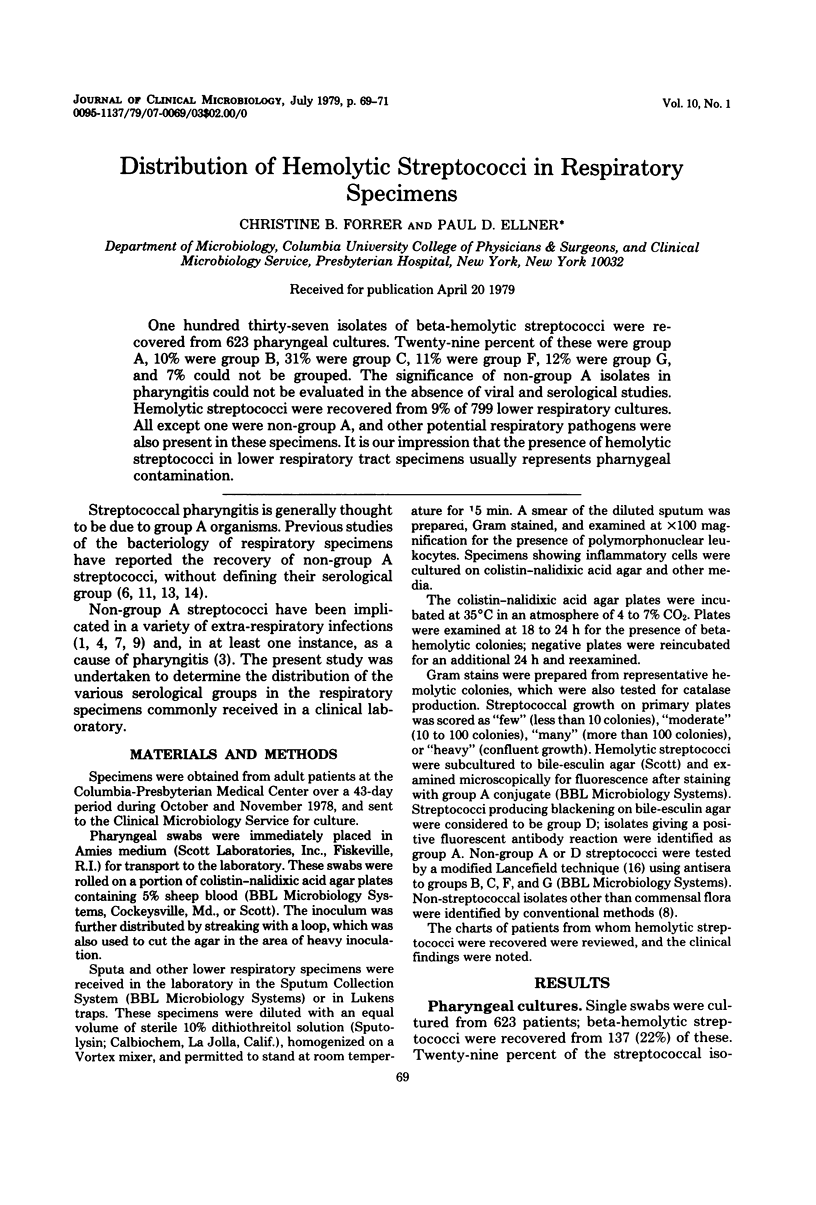Abstract
One hundred thirty-seven isolates of beta-hemolytic streptococci were recovered from 623 pharyngeal cultures. Twenty-nine percent of these were group A, 10% were group B, 31% were group C, 11% were group F, 12% were group G, and 7% could not be grouped. The significance of non-group A isolates in pharyngitis could not be evaluated in the absence of viral and serological studies. Hemolytic streptococci were recovered from 9% of 799 lower respiratory cultures. All except one were non-group A, and other potential respiratory pathogens were also present in these specimens. It is our impression that the presence of hemolytic streptococci in lower respiratory tract specimens usually represents pharnygeal contamination.
Full text
PDF


Selected References
These references are in PubMed. This may not be the complete list of references from this article.
- Bannatyne R. M., Randall C. Ecology of 350 isolates of group F Streptococcus. Am J Clin Pathol. 1977 Feb;67(2):184–186. doi: 10.1093/ajcp/67.2.184. [DOI] [PubMed] [Google Scholar]
- Bartlett J. G. Diagnostic accuracy of transtracheal aspiration bacteriologic studies. Am Rev Respir Dis. 1977 May;115(5):777–782. doi: 10.1164/arrd.1977.115.5.777. [DOI] [PubMed] [Google Scholar]
- Benjamin J. T., Perriello V. A., Jr Pharyngitis due to group C hemolytic streptococci in children. J Pediatr. 1976 Aug;89(2):254–256. doi: 10.1016/s0022-3476(76)80459-3. [DOI] [PubMed] [Google Scholar]
- Braunstein H., Tucker E., Gibson B. C. Infections caused by unusual beta hemolytic streptococci. Am J Clin Pathol. 1971 Apr;55(4):424–430. doi: 10.1093/ajcp/55.4.424. [DOI] [PubMed] [Google Scholar]
- Briggs D. D., Jr Pulmonary infections. Med Clin North Am. 1977 Nov;61(6):1163–1183. doi: 10.1016/s0025-7125(16)31254-8. [DOI] [PubMed] [Google Scholar]
- CORNFELD D., HUBBARD J. P. A four-year study of the occurrence of beta-hemolytic streptococci in 64 school children. N Engl J Med. 1961 Feb 2;264:211–215. doi: 10.1056/NEJM196102022640502. [DOI] [PubMed] [Google Scholar]
- Feingold D. S., Stagg N. L., Kunz L. J. Extrarespiratory streptococcal infections. Importance of the various serologic groups. N Engl J Med. 1966 Aug 18;275(7):356–361. doi: 10.1056/NEJM196608182750704. [DOI] [PubMed] [Google Scholar]
- Freedman P., Meister H. P., Lee H. J., Smith E. C., So B. S., Nidus B. D. The renal response to streptococcal infection. Medicine (Baltimore) 1970 Nov;49(6):433–463. doi: 10.1097/00005792-197011000-00001. [DOI] [PubMed] [Google Scholar]
- Margileth A. M., Mella G. W., Zilvetti E. E. Streptococci in children's respiratory infections: diagnosis and treatment. Clinical characteristics of pharyngitis related to group A streptococci and practical utility of nose and throat bacteriology in office practice. Clin Pediatr (Phila) 1971 Feb;10(2):69–77. doi: 10.1177/000992287101000206. [DOI] [PubMed] [Google Scholar]
- Murray P. R., Wold A. D., Washington J. A., 2nd Recovery of group A and nongroup A beta-hemolytic streptococci from throat swab specimens. Mayo Clin Proc. 1977 Feb;52(2):81–84. [PubMed] [Google Scholar]
- Quinn R. W., Lowry P. N. The anatomical area of involvement in streptococcal infections and the carrier state. Yale J Biol Med. 1970 Aug;43(1):1–10. [PMC free article] [PubMed] [Google Scholar]
- RANTZ L. A., RANDALL E. Use of autoclaved extracts of hemolytic streptococci for serological grouping. Stanford Med Bull. 1955 May;13(2):290–291. [PubMed] [Google Scholar]


